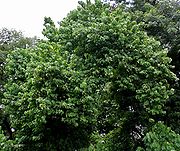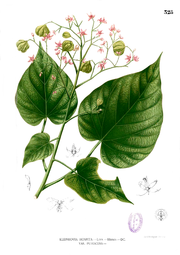
Kleinhovia hospita
Encyclopedia
Kleinhovia hospita is an evergreen
, tropical tree native to Indonesia
, Malaysia and other parts of tropical Asia. It is monotypic, being the only species in its genus.


_in_hyderabad,_ap_w_img_0480.jpg) K. hospita is an evergreen, bushy tree growing up to 20 m high, with a dense rounded crown and upright pink sprays of flowers and fruits. Leaves are simple and alternate; stipule
K. hospita is an evergreen, bushy tree growing up to 20 m high, with a dense rounded crown and upright pink sprays of flowers and fruits. Leaves are simple and alternate; stipule
s are ensiform to linear, about 8 mm long; petiole
s are 2.5-30 cm long; the leaf-blade is ovate to heart-shaped, glabrous on both sides, with the apex pointed. Secondary veins occur in 6-8 pairs, palmately nerved.
The flower
s of K. hospita are terminal, in loose panicle
s protruding from the crown; flowers are about 5 mm wide, coloured pale pink; pedicel
s are 2-10 mm long; bracteoles are lanceolate, 2-4 mm long, pubescent; gynandrophores are 4-7 mm long, pubescent; there are 5 sepals, linear lanceolate, 6-8 mm long, pink, tomentose
; 5 petals, inconspicuous, the upper one being yellow; 15 stamens, monaldelphous, 8-15 mm long, staminal tube broadly campanulate, adanate to gynandrophore, 5-lobed, each lobe having 3 anthers and alternating with staminodes; the anthers are sessile and extrorse; pistil occur with a 5-celled, pilose ovary, one style and a capitate, with a 5-lobed stigma. K. hospita flowers throughout the year.
Fruit production starts early, often in the third year after planting. The fruit of K. hospita are rounded, 5-lobed, thin-walled, membranous capsules, 2-2.5 cm in diameter, loculicidally dehiscent, each locule having 1-2 seeds. The seeds are globose, whitish, warty and exalbuminous. The fruits are more conspicuous than the flowers because of their abundance and size.
to treat scabies. The bark and leaves used as hairwash for lice, while the juice of the leaves are used as an eyewash. Young leaves are eaten as a vegetable. Bast fibre
s are used for making ropes used for tying or for tethering livestock.
The wood of K. hospita shows a pinkish buff and is moderately fine in texture, soft, light, easy to season, work and finish. Its energy value is about 19000 kJ
/kg. The leaves and bark contain cyanogen
ic compounds that are assumed to help to kill ectoparasites such as lice. Extracts of the leaves have shown anti-tumour activity against sarcoma
in mice. A number of fatty acid
s with a cyclopropenylic ring (scopoletin
, kaempferol
, and quercetin
) have been isolated from the leaves.
K. hospita is used for ornamental purposes: the attractiveness of the pink
panicles accounts for its spread as an ornamental
.
Evergreen
In botany, an evergreen plant is a plant that has leaves in all seasons. This contrasts with deciduous plants, which completely lose their foliage during the winter or dry season.There are many different kinds of evergreen plants, both trees and shrubs...
, tropical tree native to Indonesia
Indonesia
Indonesia , officially the Republic of Indonesia , is a country in Southeast Asia and Oceania. Indonesia is an archipelago comprising approximately 13,000 islands. It has 33 provinces with over 238 million people, and is the world's fourth most populous country. Indonesia is a republic, with an...
, Malaysia and other parts of tropical Asia. It is monotypic, being the only species in its genus.
Description


_in_hyderabad,_ap_w_img_0480.jpg)
Stipule
In botany, stipule is a term coined by Linnaeus which refers to outgrowths borne on either side of the base of a leafstalk...
s are ensiform to linear, about 8 mm long; petiole
Petiole (botany)
In botany, the petiole is the stalk attaching the leaf blade to the stem. The petiole usually has the same internal structure as the stem. Outgrowths appearing on each side of the petiole are called stipules. Leaves lacking a petiole are called sessile, or clasping when they partly surround the...
s are 2.5-30 cm long; the leaf-blade is ovate to heart-shaped, glabrous on both sides, with the apex pointed. Secondary veins occur in 6-8 pairs, palmately nerved.
The flower
Flower
A flower, sometimes known as a bloom or blossom, is the reproductive structure found in flowering plants . The biological function of a flower is to effect reproduction, usually by providing a mechanism for the union of sperm with eggs...
s of K. hospita are terminal, in loose panicle
Panicle
A panicle is a compound raceme, a loose, much-branched indeterminate inflorescence with pedicellate flowers attached along the secondary branches; in other words, a branched cluster of flowers in which the branches are racemes....
s protruding from the crown; flowers are about 5 mm wide, coloured pale pink; pedicel
Pedicel (botany)
A pedicel is a stem that attaches single flowers to the main stem of the inflorescence. It is the branches or stalks that hold each flower in an inflorescence that contains more than one flower....
s are 2-10 mm long; bracteoles are lanceolate, 2-4 mm long, pubescent; gynandrophores are 4-7 mm long, pubescent; there are 5 sepals, linear lanceolate, 6-8 mm long, pink, tomentose
Tomentose
Tomentose is a term used to describe plant hairs that are flattened and matted, forming a woolly coating known as tomentum. Often the hairs are silver or gray-colored...
; 5 petals, inconspicuous, the upper one being yellow; 15 stamens, monaldelphous, 8-15 mm long, staminal tube broadly campanulate, adanate to gynandrophore, 5-lobed, each lobe having 3 anthers and alternating with staminodes; the anthers are sessile and extrorse; pistil occur with a 5-celled, pilose ovary, one style and a capitate, with a 5-lobed stigma. K. hospita flowers throughout the year.
Fruit production starts early, often in the third year after planting. The fruit of K. hospita are rounded, 5-lobed, thin-walled, membranous capsules, 2-2.5 cm in diameter, loculicidally dehiscent, each locule having 1-2 seeds. The seeds are globose, whitish, warty and exalbuminous. The fruits are more conspicuous than the flowers because of their abundance and size.
Uses
K. hospita is used as a traditional medicine in parts of Malaya, Indonesia and Papua New GuineaPapua New Guinea
Papua New Guinea , officially the Independent State of Papua New Guinea, is a country in Oceania, occupying the eastern half of the island of New Guinea and numerous offshore islands...
to treat scabies. The bark and leaves used as hairwash for lice, while the juice of the leaves are used as an eyewash. Young leaves are eaten as a vegetable. Bast fibre
Bast fibre
Bast fibre or skin fibre is plant fibre collected from the phloem or bast surrounding the stem of certain, mainly dicotyledonous, plants. They support the conductive cells of the phloem and provide strength to the stem...
s are used for making ropes used for tying or for tethering livestock.
The wood of K. hospita shows a pinkish buff and is moderately fine in texture, soft, light, easy to season, work and finish. Its energy value is about 19000 kJ
Joule
The joule ; symbol J) is a derived unit of energy or work in the International System of Units. It is equal to the energy expended in applying a force of one newton through a distance of one metre , or in passing an electric current of one ampere through a resistance of one ohm for one second...
/kg. The leaves and bark contain cyanogen
Cyanogen
Cyanogen is the chemical compound with the formula 2. It is a colorless, toxic gas with a pungent odor.The molecule is a pseudohalogen. Cyanogen molecules consist of two CN groups — analogous to diatomic halogen molecules, such as Cl2, but far less oxidizing...
ic compounds that are assumed to help to kill ectoparasites such as lice. Extracts of the leaves have shown anti-tumour activity against sarcoma
Sarcoma
A sarcoma is a cancer that arises from transformed cells in one of a number of tissues that develop from embryonic mesoderm. Thus, sarcomas include tumors of bone, cartilage, fat, muscle, vascular, and hematopoietic tissues...
in mice. A number of fatty acid
Fatty acid
In chemistry, especially biochemistry, a fatty acid is a carboxylic acid with a long unbranched aliphatic tail , which is either saturated or unsaturated. Most naturally occurring fatty acids have a chain of an even number of carbon atoms, from 4 to 28. Fatty acids are usually derived from...
s with a cyclopropenylic ring (scopoletin
Scopoletin
Scopoletin is a coumarin found in the root of plants in the genus Scopolia like Scopolia carniolica or Scopolia japonica, in chicory, in Artemisia scoparia, in the passion flower, in Brunfelsia, in Viburnum prunifolium or Kleinhovia hospita...
, kaempferol
Kaempferol
Kaempferol is a natural flavonol, a type of flavonoid, that has been isolated from tea, broccoli, Delphinium, Witch-hazel, grapefruit,cabbage, kale, beans, endive, leek, tomato, strawberries, grapes, brussels sprouts, apples and other plant sources. Kaempferol is a yellow crystalline solid with a...
, and quercetin
Quercetin
Quercetin , a flavonol, is a plant-derived flavonoid found in fruits, vegetables, leaves and grains. It also may be used as an ingredient in supplements, beverages or foods.-Occurrence:...
) have been isolated from the leaves.
K. hospita is used for ornamental purposes: the attractiveness of the pink
Pink
Pink is a mixture of red and white. Commonly used for Valentine's Day and Easter, pink is sometimes referred to as "the color of love." The use of the word for the color known today as pink was first recorded in the late 17th century....
panicles accounts for its spread as an ornamental
Ornamental plant
Ornamental plants are plants that are grown for decorative purposes in gardens and landscape design projects, as house plants, for cut flowers and specimen display...
.
General references
- Latiff, A., 1997. Kleinhovia hospita L. in Faridah Hanum, I. & van der Maesen, L.J.G. (Eds.): Plant Resources of South-East Asia No. 11. Auxiliary Plants. Prosea Foundation, BogorBogorBogor is a city on the island of Java in the West Java province of Indonesia. The city is located in the center of the Bogor Regency , 60 kilometers south of the Indonesian capital Jakarta...
, Indonesia; url source: Species Information, retrieved on 29 June, 2007.

